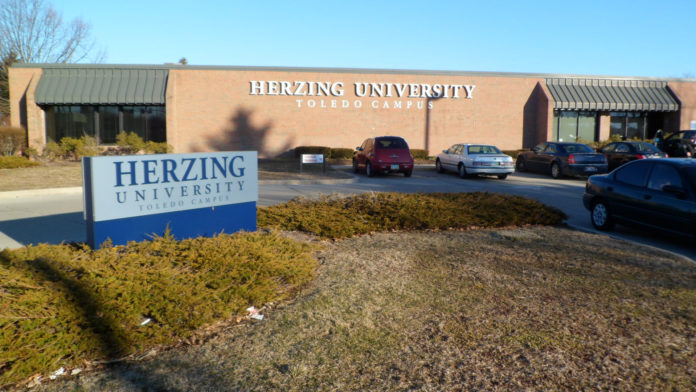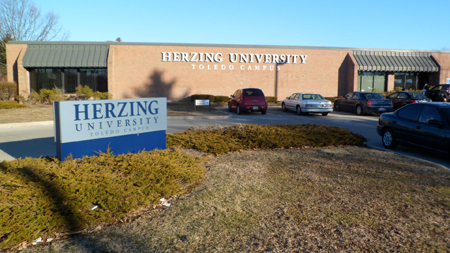Herzing University Toledo will sign an agreement with Owens Community College within days establishing a “3+1” program between the two schools.
“It is an effort to make higher education more affordable and attainable,” said Kevin Milliken, community relations coordinator for Herzing. “This ‘3+1’ program is unique to the Toledo campus. It’s the first time we’ve ever done something like this. We have to continue to find unique and creative ways to help students afford and access higher education, as well as retain them and help them complete.”
The 2010 census reports that one in three adults living in Lucas County currently has at least an associate degree. One in 11 has at least a bachelor’s degree.
“And that’s worse than even the Appalachian regions of southern Ohio,” Milliken said. “The census broke down adult education county by county. Lucas County is pretty much in the middle of the pack with that one in three [statistic]. But because Ohio is an industrial state, there’s the manufacturing mentality that says if you get a high school diploma, you can get a job on the assembly line and make good money. Of course, those days are long gone.”
By 2020, the Ohio Board of Regents projects that three of every five jobs in Ohio will require some form of higher education.
“That’s not necessarily a four-year college degree, but an associate degree or a diploma or certificate program — something — because of technological advancements,” Milliken said. “And that’s seven short years from where we currently are in Lucas County.
“My message (when speaking to high school students) in the classrooms is a high school diploma is now a one-way ticket to working poor. That’s a message from the organization Complete College America.”
Milliken will follow up the March 28 Transfer Fair hosted by Owens for its students graduating with associate degrees when he meets with interested students April 2 at Owens at 10:30 a.m.
Significant cost savings
Milliken said the “3+1” program allows students to take three years of classes at Owens and the final three semesters at Herzing. “3+1” will save students almost $20,000 on the cost of a traditional four-year liberal arts university bachelor degree program.
“What this does is accomplish a couple of things,” Milliken said. “No. 1, it allows students to attend a community college at a lower per credit hour cost. It also allows them to finish in a reasonable amount of time, saving that kind of money so they’re not up to their necks in student loan debt.”
Options for students
Doug Bullimore, assistant director of transfer partnerships at the Toledo campus at Owens, said he is glad Owens signed the agreement.
“I’m always looking for different options for our students after they earn their associate degree,” Bullimore said. “The whole educational system is changing. We are going through a renaissance. This ‘3+1’ program can give our students another avenue to follow.”
Herzing’s “3+1” program will allow students to take three years of classes at Owens, where tuition is $146.03 per credit hour, as opposed to Bowling Green State University ($359), The University of Toledo ($327.66) or Herzing University ($460).
However, Milliken said the cost of classes at both UT and BGSU are closer to the $450 Herzing charges.
“When you look at Herzing’s per-semester cost, we are right there in the ballpark with UT and BGSU because they stack all those fees on top of everything,” he said.
Additional BGSU costs
BGSU’s website reports that students pay a $59 fee for each credit hour, which makes one academic credit hour actually cost $418. BGSU’s website also estimates book and academic supplies will cost $1,194 annually.
Students also pay a mandatory $61 per credit hour fee with a maximum charge of $732 a semester “to attend most campus activities and athletic events free or at a reduced admission fee.” This fee also supports the student union, intramural sports, and “other student services, activities and related capital projects” and allows full-time students access to the Rec Center and Perry Field House.
A parking permit costs $60 a semester or $100 a year.
The website also lists 49 other fees ranging from $7 to $720 per semester that students could potentially be required to pay.
The website also informs students that “fees are subject to change at any time with Board of Trustees’ approval.”
Additional UT costs
UT’s website reports that students pay an additional $49.60 fee for each credit hour, which makes one academic credit hour actually cost $377.26. UT’s website also estimates the “typical annual cost of books” at $750.
A parking permit costs $120 a semester or $240 a year.
The website provides a link to a 17-page PDF from The Office of the Treasurer that identifies technology fees calculated by the college in which a student is enrolled, ranging in price from $1.25 to $17.50 per credit hour.
The document also lists 21 “miscellaneous fees” ranging from $3 per credit hour to $4,825 a year that students could potentially be required to pay. The document also lists four of the miscellaneous fee categories as “vary by course.”
The website informs students that “fees are for a typical fall/spring semester, 15-week course. Application and new student registration fees may also apply. Tuition and fees are subject to change.”
Additional Owens costs
Owens’ website reports that unlike BGSU and UT, Owens does not attach a fee to the cost of a credit hour. The advertised $146.03 cost is final.
The website lists five required fees. Two are one-time fees — an application fee ($20) and a new student orientation fee ($65).
Recurring required fees are registration fees ($10), laboratory fees, which vary by course, and academic support service fees ($110).
Owens lists 12 optional fees, ranging in cost from $5 per academic program to $50 per semester. Owens does not charge a parking fee.
‘No fee’ policy
“We don’t stack fees,” Milliken said. “We include the cost of books (in the price of a credit hour), and we don’t add any fees. We even pay for any certification test that a student would need. For example, our new information technology program will include some Cisco (Computer Information System Company) certifications. If someone has to sit for a Cisco certification test, we pay that fee as a part of their tuition.
“We don’t have technology fees, special services fees, program fees and parking fees. If you were to take a look at the typical bill for a public university, you could see as many as six to 10 different kinds of fees. When the state legislature puts a tuition freeze on what public colleges and universities can charge, those institutions generate additional revenue by establishing fees.”
Global marketplace
“This is career-oriented stuff where graduates can walk right in the door and do the job because, built into our curriculum, we’re using actual case studies that companies faced in logistics, product ordering, HR, benefits, financial accounting — every aspect of the global marketplace,” Milliken said.
Milliken said Herzing’s Software Applications Platform (SAP) component to the curriculum makes its graduates more marketable.
“SAP is the software system that 60 percent of the world’s companies use, including local employers such as the City of Toledo, Owens-Illinois, Owens Corning, The Andersons and Chrysler,” Milliken said. “It’s in demand, especially in Northwest Ohio.”
Milliken said SAP allows various software programs that companies use to talk to each other and expand out into all types of devices, including personal computers, smartphones, tablets and the Web. Milliken said SAP allows companies to present information in user-friendly ways.
Liberal arts four-year colleges and universities teach the theory behind SAP and other computing platforms, but they don’t offer students the hands-on training in operating platforms that Herzing provides, Milliken said.
“When graduates walk out with a bachelor’s degree in business with this SAP component, they’re ready to walk into any one of our major local employers,” Milliken said. “They don’t have to leave the area to find opportunity. And we’re being told anecdotally out in the field that if you don’t have that SAP piece, many of the local employers aren’t going to look at you. Since the unemployment situation is so high right now, employers can pick and choose whom they want.”
Milliken acknowledged that critics will be skeptical of the “3+1” program, saying it is simply a marketing ploy that a for-profit university is using to entice more students to enroll.
“There will be naysayers out there, but until we start creating the university of the future, we’re going to miss a lot of opportunity,” Milliken said. “For the traditional bricks-and-mortar university, time is passing it by. There are almost 1,000 online programs out there. Our online bachelor’s program is now ranked 80th in the country by U.S. News & World Report. That puts us at No. 1 on Northwest Ohio and No. 2 in Ohio.”
Further implications
“We have to leverage the resources that are available to meet the students where they’re at because the adult learner, formerly known as the nontraditional student, is the norm rather than the exception these days,” Milliken said. “In order for them to complete an education, we have to work around the work-family-children-life balance. And education is just one more thing piled on all the pressures of life. And unless and until we evolve and adapt to meet those situations, we’re not going to succeed as a region.”
Milliken said Herzing is looking to expand the “3+1” program “in any way we can so that students can save money on college. It’s something that may be a good fit for Northwest State [Community College, with its main campus in Archbold and satellite campuses in Bryan, Van Wert and Whitehouse] or Terra [Community College in Fremont], but those discussions have not been completed. The idea has been introduced to their leadership, but further discussions are obviously needed.”
Milliken said reciprocity programs like “3+1” could be expanded to programs both schools have in common, including:
- Technology programs in computer networking, network management, security technology and technology management.
- A public safety program in criminal justice.
- Health care programs in health information management, health care management, insurance billing and coding, medical assistance services and surgical technology.
- Business programs in accounting, business management and paralegal services.
“Anything that we offer could be pursued at a higher level toward a bachelor’s degree,” he said. “Anything we offer is a logical candidate for such a ‘3+1’ program.”
Milliken said Greg Guzman, Herzing campus president, gets all the credit for establishing the program.
“Greg used to work at Owens so he has some ongoing relationships there,” Milliken said. “What gives us such a foothold here is that Greg has worked in higher education in many of Northwest Ohio’s public universities, including Owens, Lourdes [University] and Bowling Green [State University].
“As institutions of higher education, we have to do a better job of meeting all students where they’re at and structure programs accordingly to do two things — help them achieve success and give them the tools and the tool belt necessary for what the workforce demands.
“And if we’ve done neither or either, then we’ve failed the students who are investing in their future success.”
























